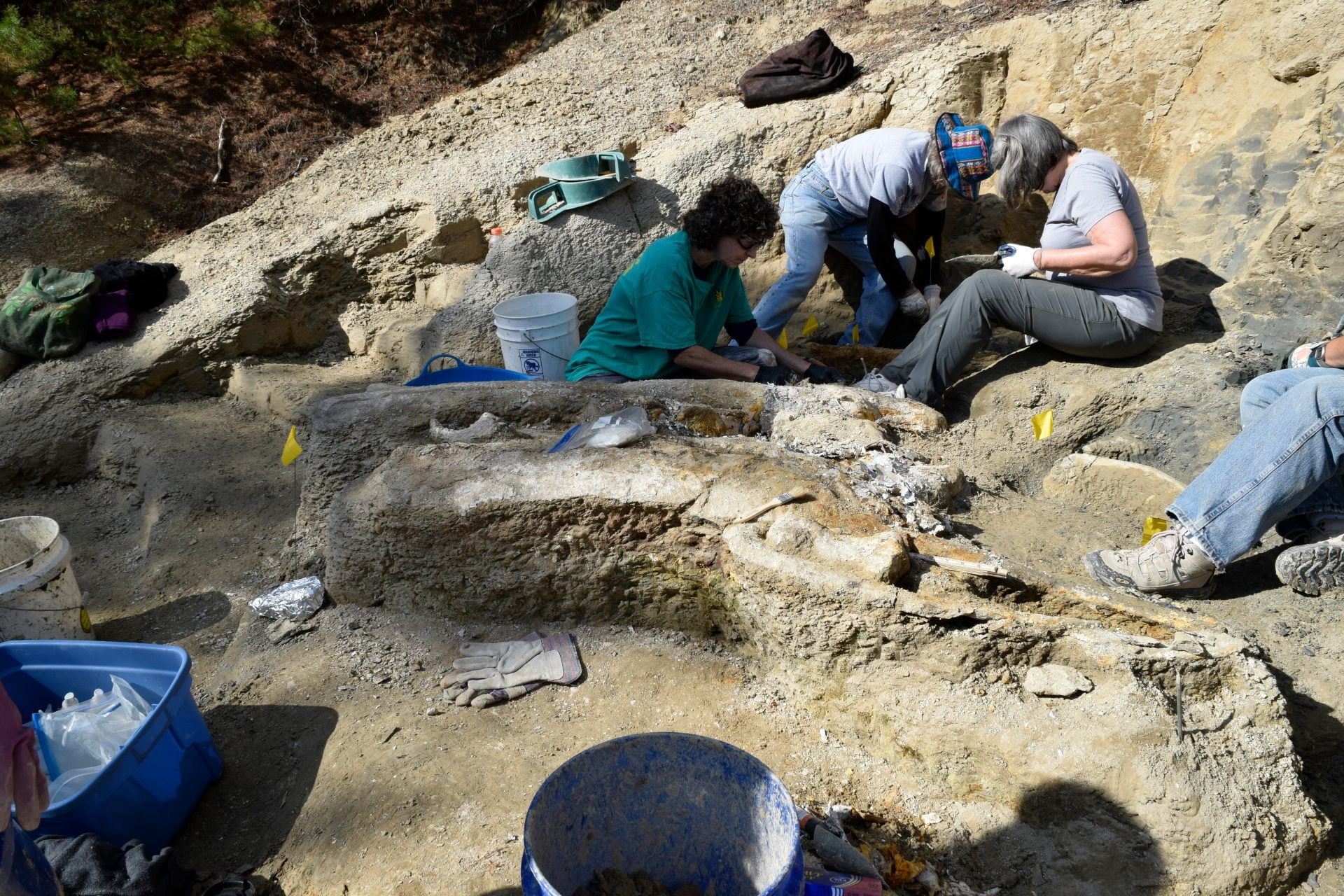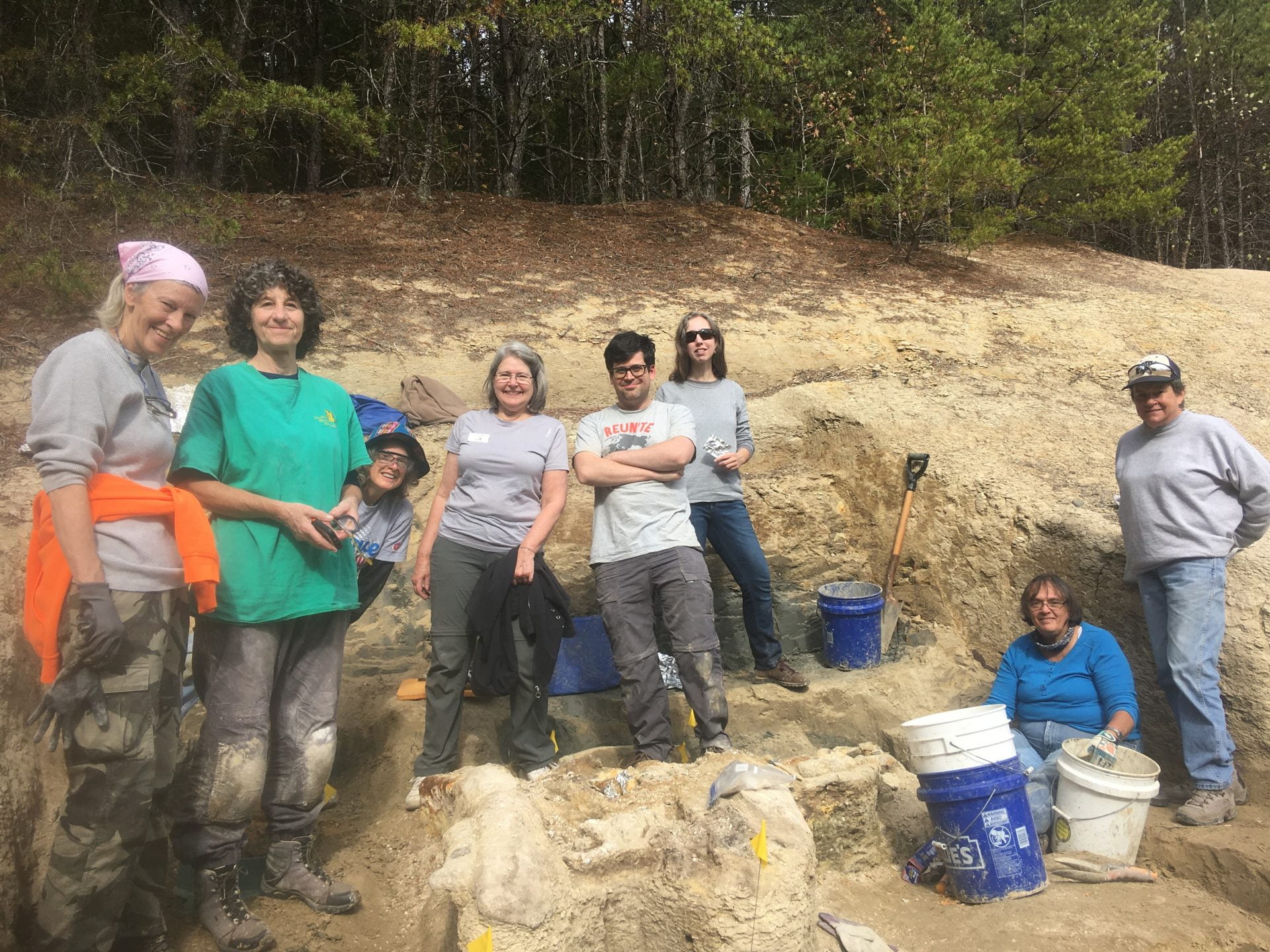
By BEN R. WILLIAMS
Fourteen million years ago, what is now the city of Richmond was underwater, the skyline filled with whales, fish, sharks and crocodiles rather than bright lights and towering buildings.
In early November, researchers and volunteers from the Virginia Museum of Natural History (VMNH) traveled to the Carmel Church quarry just outside of Richmond to unearth some of the extinct creatures that once swam above the state capitol.
VMNH Assistant Curator of Paleontology Dr. Adam Pritchard, who joined the museum in August, said that he chose to do his first dig as a VMNH curator at Carmel Church for a few reasons. One reason was that the museum’s research technicians spoke highly of the site, he said.
“Carmel Church is a pretty remarkable resource that the museum has access to,” Pritchard said. “It’s actually quite different from a lot of the places I’ve dug in the past. It’s from after the extinction of the dinosaurs about 66 million years ago, so all the fossils there are coming from smack-dab in the middle of the age of mammals, although there are multiple different layers from multiple different ages within that time. It’s a really cool site, and that’s part of the reason I wanted to start out there.”
There aren’t any dinosaurs to be found at Carmel Church (and in fact, no dinosaur fossils have ever been found within Virginia), but what it does offer is a unique glimpse of the organisms that proliferated after the Cretaceous-Paleogene extinction event – the asteroid that killed the dinosaurs.
The quarry
Researchers from VMNH have been traveling to Carmel Church since 1984, Pritchard said. The quarry is located in Ruther Glen, Va., and its closest urban center is Richmond. The quarry is owned by Martin Marietta Associates, which is not currently using the quarry, but keeps the lease active allowing VMNH staff to visit and dig for fossils.
“We have a very positive relationship with Martin Marietta, which is an awesome thing that doesn’t always happen in paleontology, so you have to treasure that when that kind of connection exists,” Pritchard said.
Pritchard, alongside VMNH Research Technician Lucy Treado and a host of VMNH volunteers, spent about a week digging at the quarry, their focus on a rock outcrop measuring about 30 feet high and hundreds of feet long. Most of the outcrop can be divided into three different time periods, Pritchard said, offering up fossils that date between seven million and 50 million years old.
The whale
Carmel Church has a reputation for being home to a large variety of whales, most of them dating back to about 14 million years ago. Many of these whales were filter-feeding baleen whales, similar to the humpback and blue whales that are still around today.
One such whale is Eobalaenoptera, an extinct species of whale first described by VMNH researchers in June 2004. A cast replica of Eobalaenoptera is suspended from the ceiling in the VMNH Hall of Ancient Life and at the Caroline County Visitors Center in Ruther Glen, VA. The species is closely related to modern-day humpback and blue whales.
According to Pritchard, another baleen whale was discovered at Carmel Church last year, although there was not enough time to extract it from the surrounding rock.
“Part of the big objective with this trip was not necessarily to find new stuff, but to protect one of the more impressive discoveries from the prior expedition,” Pritchard said. “A year ago, a large skull and partial front-end of a skeleton of a baleen whale was discovered in the uppermost layer. … It was covered over with a ‘winter jacket,’ a burlap and plaster protective layer to keep it from being eroded or damaged before we could come back. This new skull is from slightly younger rocks, which are around 10 million years old. Part of what makes it exciting is the relative lack of whale fossils from Carmel Church in that time period.”
There wasn’t time to completely extricate the whale this year either, Pritchard said, although researchers and volunteers made progress in finding the edges of the skull and building a new protective jacket, and Pritchard said he hopes to return to Carmel Church in the spring and excavate the rest of the creature’s massive skull and bring it back to the museum.
As for whether this whale represents a new species, Pritchard said it’s too early to tell; many of the finer details of the anatomy of the skull are still buried in rock.
“We can definitively say it’s a baleen whale,” Pritchard said. “It also has a skull that’s maybe five feet or so in length. It’s a sizeable critter.”
It may seem hard to believe that a whale skeleton would be found about 75 miles from the Atlantic coast.
However, Pritchard said, “sea levels change, especially at this point in Earth’s history, 14 million years ago, when these whales were swimming overtop of what is now Richmond. The sea level was substantially higher and the coastline was far further inland, to the point where Carmel Church is capturing this near-shore ecosystem from the middle of the Miocene epoch.”

The crocodile
Pritchard’s specialty is ancient reptiles, and so he was particularly excited when a volunteer stumbled across a type of fossil that had never before been found at Carmel Church.
“One of the volunteers – Barbara Hadley – had the good fortune, while prospecting around the site, to discover a large pile of gnarled, sculptured-looking bones,” Pritchard said. “One of the other volunteers recognized the odd sculpturing patterns as something characteristic of crocodilian skulls.”
While crocodiles are often referred to as “living fossils,” Pritchard said, this description isn’t quite true.
“Although they’ve maintained a lot of consistent anatomical traits through time … there’s actually a lot of different species that have lived over the past 80 or so million years,” he said. “There have been discoveries at the Carmel Church site … lots of nice teeth and armor plates of crocodilians from 14 million years ago. At that point, the Earth’s climate and the ocean temperatures were sufficient to allow 20, 25 foot crocs to swim off the shore overtop of what is now Richmond. Before this trip, we really didn’t have anything more than teeth and armor plates.”
Pritchard said that it’s going to be exciting to assemble this crocodile skull and see what new information can be learned from it.
“It’s tempting to imagine these crocs chowing down on whales from this time period, but I can’t say that for certain,” Pritchard added. “I’ll leave you with that image, anyway.”




